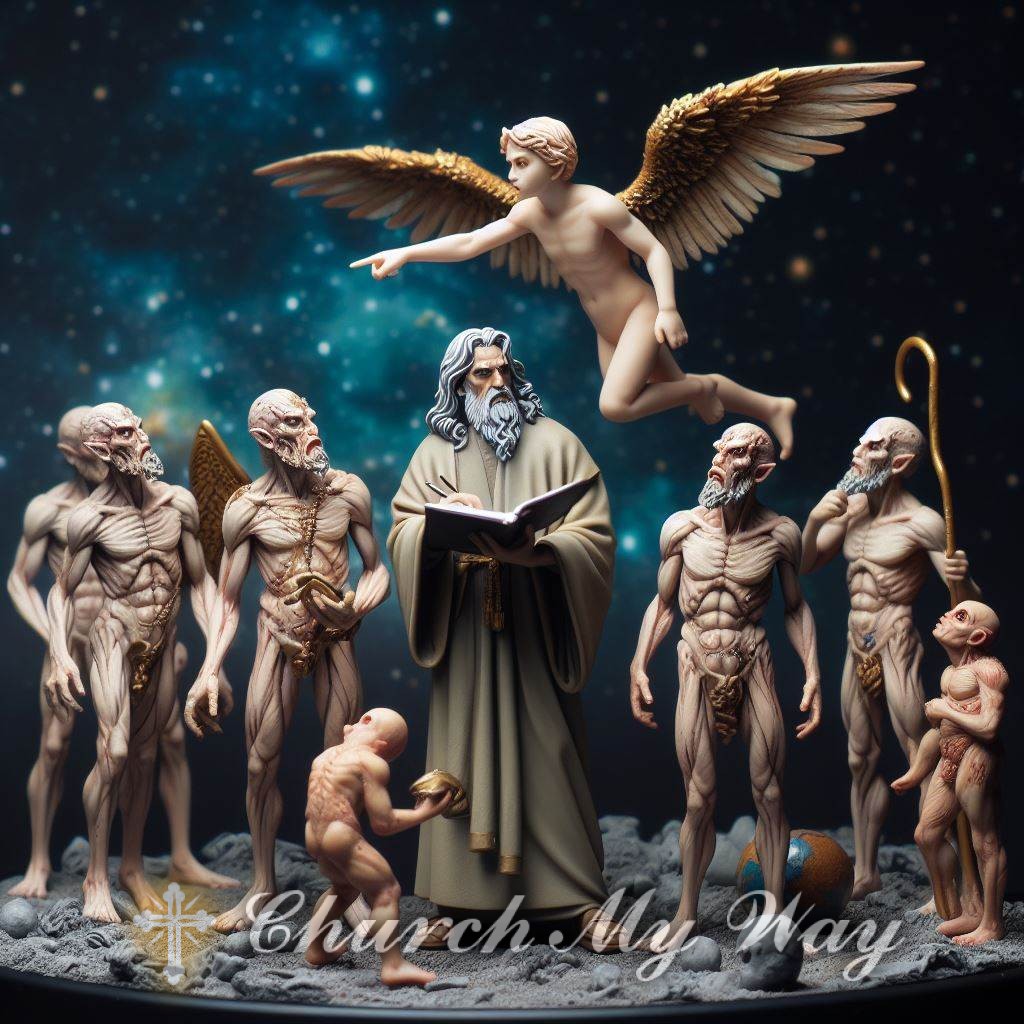The Origins and Lessons of the Nephilim
The term Nephilim likely conjures up images of towering, mythical giants or alien-human hybrids for many readers. But who – or what – were the Nephilim? This biblical concept has fascinated people for millennia, leading to much debate and speculation. In this article, we’ll explore the shadowy origins of these controversial figures, the lessons their mention in scripture may provide, and why their legacy continues to intrigue.
Defining the Mysterious Nephilim
The Nephilim first appears in the Bible in Genesis 6:1-4, which states:
When man began to multiply on the face of the land and daughters were born to them, the sons of God saw that the daughters of man were attractive. And they took as their wives any they chose…
The Nephilim were on the earth in those days, and also afterward, when the sons of God came into the daughters of man and they bore children to them. These were the mighty men who were of old, the men of renown.
This short, cryptic passage tells us several important things:
– The “sons of God” took human women as wives
– Their offspring were the Nephilim
– The Nephilim were physically imposing and famous
But who were the “sons of God“? And how exactly did they relate to the Nephilim? Biblical scholars have debated these questions for ages and formed two major theories:
The Fallen Angels Theory: The “sons of God” were angels – elaborate spiritual beings who fell from grace or rebelled against God. They bred attractive human women, and their unnatural union produced giants known as the Nephilim.
The Godly Descendants Theory: The “sons of God” were not heavenly beings, but rather the godly male descendants of Seth – the third son of Adam and Eve. As they intermarried with the “daughters of man” – the female descendants of Cain – their pious family line was corrupted, leading to the rise of the brutal and powerful Nephilim.
In either case, the Nephilim were likely considered monstrous aberrations – byproducts of an unholy mingling between two bloodlines that should have remained separate. For many biblical scholars, they represented the increasing human wickedness that eventually brought about Noah’s great flood.
The Legacy of the Nephilim
While the flood may have culled their numbers, there are hints in scripture that the Nephilim bloodline endured even afterward. Numbers 13:32-33 tells of Canaanite people the ancient Israelites encountered called the Anakites – a tall, strong people said to be descendants of the Nephilim:
And they spread among the Israelites a bad report about the land they had explored. They said,
“The land we explored devours those living in it. All the people we saw there were of great size. We saw the Nephilim there (the descendants of Anak come from the Nephilim). We seemed like grasshoppers in our own eyes, and we looked the same to them.”
This passage suggests that remnants of the Nephilim survived the flood and founded fearsome tribes, passing their impressive genes down to generations that followed. They were giants among men who could make others feel tiny and powerless in their presence.
If true, this has sobering theological implications. It suggests that even God’s wrathful judgment was not enough to fully eliminate the stain of whatever unholy forces initially spawned the Nephilim. Their enduring legacy could be seen as a type of evil that continually returns to menace humanity no matter how hard we try to scrub it out.
Of course, tales of giants have echoed across many ancient cultures over the centuries, well beyond the biblical accounts. From the frost giants of Norse myths to folktales of towering human oddities, these outsized beings fascinate us. Perhaps on some deeper psychological level, we love the idea that there could be spectacular beings walking the earth well beyond the normal human scale.
The Nephilim represent this timeless allure – these were history’s first “famous giants,” possessing superhuman size and strength. Maybe early humans hoped to explain the bones of massive prehistoric creatures they stumbled across by imagining they belonged to mythic, humanoid giants. Over time, such findings probably contributed to legends of giant beings coexisting with early man.
So while the Nephilim were initially presented as frightening examples of unchecked evil, our collective imagination has transformed them into something arguably more positive – the epitome of powerful, epic heroes that stand head and shoulders above the rest of us mere mortals.
For modern creators of fiction, TV shows, movies, and games drawing on themes of giants, Nephilim, and other colossal humanoids, keeping these complex roots in mind is important.
Audiences may cheer on the likes of Game of Thrones’ Gregor “The Mountain” Clegane, but scripture reminds us that such mighty beings often brought much suffering when they walked the earth.
Lessons from the Nephilim
Whether or not one interprets the Nephilim as literal giants, their mention in Genesis offers some valuable lessons.
First, it warns against the hubris of unrestrained science. The “sons of God” stand in for learned men of knowledge and power who consider themselves above ethics and norms meant to govern society.
They use their advanced intellect and status not for wise guidance, but to effectively commit rape against vulnerable women for their gain.
This echoes modern debates about controversial experiments many consider to cross ethical lines – gene editing, cloning, chimera research, and so on. Science divorced from ethics risks breeding monsters.
Second, it serves as a cautionary tale against the uninhibited mixing of species, people groups, and ways of life fundamentally opposed to one another – the intermingling of two bloodlines that should remain untainted. The monstrous Nephilim arises from the marriage of the sacred and the profane. This carries resonances of concerns about unchecked immigration and multiculturalism leading to social strife as divergent cultures attempt to live side-by-side in the same lands.
Finally, and perhaps most importantly, the Nephilim represents the dangers of accumulating too much power and influence with too little accountability. Scripture strongly warns against the rise of mighty individuals who gain renown and prestige by brute force, inspiring terror in people’s hearts rather than earning their genuine respect.
Their outsized bodies are merely manifestations of their outsized egos. This remains incredibly relevant today, as leaders across realms like business, politics, and entertainment continue struggling with issues of abuse, corruption, and lack of accountability.
None of us likely possess the physical might of the Nephilim, but we all have domains where we exercise power and influence – whether in our jobs as bosses and managers, within community organizations we participate in, or even just as prominent voices on social media. The lesson of the Nephilim is that with great power comes great responsibility. We must temper it with humility, ethics, and compassion.
The Allure of the Unknown Remains
The true nature of the Nephilim is likely lost to the mists of time and layers of interpretation by countless scholars. Biblical literalists argue they were actual physical giants, the grotesque progeny of lustful angels and human women.
More skeptical academics suggest they were inventive mythological fabrications meant to illustrate humanity’s moral slide towards wickedness and away from God.
But the fascination persists, with more questions than firm answers.
Why do so many ancient cultures feature myths of giants coexisting with humans?
What drove these stories featuring lustful gods coming to earth to breed with mortals?
Do massive bones dug up by archaeologists belong to a race of giants from our prehistory?
The Nephilim represent an enduring aura of mystery – we don’t know nearly as much as we want to about them, leaving space for imagination to run wild. And perhaps that is the most compelling legacy they leave us with today.
In the Internet age, speculation about Nephilim fills endless web pages, YouTube videos, podcasts, and forums with lively discussion and debate.
Theories range from the fringe to the seemingly well-researched. But they all tap into that fundamental human drive – that nagging sense that there are extraordinary secrets still hidden out there in the world, waiting to be uncovered. The Nephilim scratch that itches. They represent the desire to peel back the layers of the ordinary and expose wondrous truths lying beneath.
This powerful allure means the Nephilim are unlikely to fade away anytime soon. Even with the considerable lengths of time since they first emerged in ancient texts, they continue capturing our collective creativity. As filmmakers, game developers, writers, and other artists search for new wellsprings of fantasy fiction inspiration, the Nephilim offers plenty of untapped creative potential, with built-in name recognition rooted in history to boot.
In the years ahead, look for this mystique to spawn continued nephilim storylines across media formats that explore their possible origins, descendants, and meanings with innovative spins. Perhaps one of those imaginative tales will uncover possibilities closer to the underlying truth than we yet realize.
For now, the Nephilim remain shrouded purposefully in mystery, not unlike the “sons of God” who birthed them. And that is perhaps how they will always be most powerfully preserved in cultural memory – as primeval echoes of knowledge once possessed, now lost to time, still sparking wonder about our foggy past.








